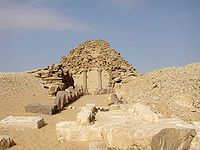
Pyramid of Sahure
Encyclopedia

Ancient Egypt
Ancient Egypt was an ancient civilization of Northeastern Africa, concentrated along the lower reaches of the Nile River in what is now the modern country of Egypt. Egyptian civilization coalesced around 3150 BC with the political unification of Upper and Lower Egypt under the first pharaoh...
ian pyramid
Pyramid
A pyramid is a structure whose outer surfaces are triangular and converge at a single point. The base of a pyramid can be trilateral, quadrilateral, or any polygon shape, meaning that a pyramid has at least three triangular surfaces...
located in Abusir
Abusir
Abusir is the name given to an Egyptian archaeological locality – specifically, an extensive necropolis of the Old Kingdom period, together with later additions – in the vicinity of the modern capital Cairo...
, Egypt. The pyramid was built during the fifth dynasty
Fifth dynasty of Egypt
The fifth dynasty of ancient Egypt is often combined with Dynasties III, IV and VI under the group title the Old Kingdom. Dynasty V dates approximately from 2494 to 2345 BC.-Rulers:...
by pharaoh
Pharaoh
Pharaoh is a title used in many modern discussions of the ancient Egyptian rulers of all periods. The title originates in the term "pr-aa" which means "great house" and describes the royal palace...
Sahure
Sahure
- Etymology :Sahure's birth name means "He who is Close to Re". His Horus name was Nebkhau.- Biography :Sahure was a son of queen Neferhetepes, as shown in scenes from the causeway of Sahure's pyramid complex in Abusir. His father was Userkaf. Sahure's consort was queen Neferetnebty. Reliefs show...
. The pyramid was known in ancient Egyptian as "Sahure's soul rises" (or "the soul of Sahure appears") and was one of the first pyramids built in its locale. In antiquity the pyramid was famous for its art, and it is now recognized as a milestone in ancient Egyptian tomb architecture.
Construction
Sahure's pyramid was constructed of roughly cut limestoneLimestone
Limestone is a sedimentary rock composed largely of the minerals calcite and aragonite, which are different crystal forms of calcium carbonate . Many limestones are composed from skeletal fragments of marine organisms such as coral or foraminifera....
blocks. To allow entrance to the burial chamber a level entrance passage, which was later plugged with granite
Granite
Granite is a common and widely occurring type of intrusive, felsic, igneous rock. Granite usually has a medium- to coarse-grained texture. Occasionally some individual crystals are larger than the groundmass, in which case the texture is known as porphyritic. A granitic rock with a porphyritic...
portcullis
Portcullis
A portcullis is a latticed grille made of wood, metal, fibreglass or a combination of the three. Portcullises fortified the entrances to many medieval castles, acting as a last line of defence during time of attack or siege...
es, was left open at the north side. When completed the pyramid was 47m (155 ft) high and 78.75m (258.4 ft) along each side with a slope of 50°.
The complex
The surrounding complex for the pyramid included a single satellite pyramid and a mortuary temple constructed of black basaltBasalt
Basalt is a common extrusive volcanic rock. It is usually grey to black and fine-grained due to rapid cooling of lava at the surface of a planet. It may be porphyritic containing larger crystals in a fine matrix, or vesicular, or frothy scoria. Unweathered basalt is black or grey...
, red sandstone
Sandstone
Sandstone is a sedimentary rock composed mainly of sand-sized minerals or rock grains.Most sandstone is composed of quartz and/or feldspar because these are the most common minerals in the Earth's crust. Like sand, sandstone may be any colour, but the most common colours are tan, brown, yellow,...
, and limestone. The walls of the mortuary temple were covered in an estimated 10,000 square meters (or about 107,640 square feet) of fine relief carving. The complex also included a 235m (771 ft) long causeway from the pyramid to the shores of lake Abusir.
The mortuary temple is well preserved.
Excavation
In the 19th century the pyramid was excavated by both Pering and Karl Richard LepsiusKarl Richard Lepsius
Karl Richard Lepsius was a pioneering Prussian Egyptologist and linguist and pioneer of modern archaeology.-Background:...
but little detailed excavation was undertaken at this time. A complete excavation was undertaken from 1902 till 1908 by Ludwig Borchardt
Ludwig Borchardt
Ludwig Borchardt was a German Egyptologist who was born in Berlin.-Life:Borchardt initially studied Architecture and later Egyptology under Adolf Erman. In 1895 he journeyed to Cairo and produced, with Gaston Maspero, the Catalogue of the Egyptian Museum...
. Borchardt would later write two volumes about the pyramid and his excavations.

